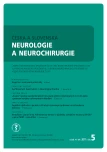Experience with a Burr-hole Craniostomy for Chronic Subdural Hematoma
Authors:
R. Kaiser 1; L. Douda 1; P. Waldauf 2
; L. Houšťava 1; P. Haninec 1
Authors‘ workplace:
3. LF UK a FN Královské Vinohrady, Praha
Neurochirurgická klinika
1; 3. LF UK a FN Královské Vinohrady, Praha
Klinika anesteziologie a resuscitace
2
Published in:
Cesk Slov Neurol N 2011; 74/107(5): 556-559
Category:
Short Communication
Overview
Chronic subdural haematoma is a very common disease of advanced age. Although often considered a trivial affection, its treatment in frequent recurrence may be difficult and its course may be fatal even if mini-invasive methods are used. The most-often used technique is evacuation via a burr-hole craniostomy, increasingly also via a simple twist-drill craniostomy. We present our experience of a group of 180 patients and a total of 201 symptomatic haematomas treated primarily by evacuation and irrigation via a small, burr-hole craniostomy. Drainage was employed in most of the cases. Risk of recurrence of haematoma led to 14.9% of the cases being re-operated. Mortality was low: 0.5% of the patients died soon after the operation. The risk of the recurrence was higher in cases of septated hematoma.
Key words:
chronic subdural hematoma – burr-hole craniostomy – craniotomy
Sources
1. Crooks DA. Pathogenesis and biomechanics of traumatic intracranial haemorrhages. Virchows Arch A Pathol Anat Histopathol 1991; 418(6): 479–483.
2. Häckel M, Benes V jr. Diagnosis and therapy of chronic subdural hematoma. Rozhl Chir 1993; 72(3): 118–123.
3. Horn EM, Feiz-Erfan I, Bristol RE, Spetzler RF, Harrington TR. Bedside twist drill craniostomy for chronic subdural hematoma: a comparative study. Surg Neurol 2006; 65(2): 150–153.
4. Weigel R, Schmiedek P, Krauss JK. Outcome of contemporary surgery for chronic subdural haematoma: evidence based review. J Neurol Neurosurg Psychiatry 2003; 74(7): 937–943.
5. Tsai TH, Lieu AS, Hwang SL, Huang TY, Hwang YF. A comparative study of the patients with bilateral or unilateral chronic subdural hematoma: precipitating factors and postoperative outcomes. J Trauma 2010; 68(3): 571–575.
6. Houdek M, Kala M, Heřman M. Interhemispheric subdural haematoma. Cesk Slov Neurol N 1996; 59/93(6): 338–340
7. Nakaguchi H, Tanishima T, Yoshimasu N. Factors in the natural history of chronic subdural hematomas that influence their postoperative recurrence. J Neurosurg 2001; 95(2): 256–262.
8. Senturk S, Guzel A, Bilici A, Takmaz I, Guzel E, Aluclu MU, Ceviz A. CT and MR imaging of chronic subdural hematomas: a comparative study. Swiss Med Wkly 2010; 140(23–24): 335–340.
9. Markwalder TM, Reulen HJ. Influence of neomembranous organisation, cortical expansion and subdural pressure on the post-operative course of chronic subdural haematoma – an analysis of 201 cases. Acta Neurochir (Wien) 1986; 79(2–4): 100–106.
10. Virchow R. Das Hämatom der Dura Mater. Verh Phys Med Ges Würzburg 1857; 7 : 134–142.
11. Mondorf Y, Abu-Owaimer M, Gaab MR, Oertel JM. Chronic subdural hematoma-craniotomy versus burr hole trepanation. Br J Neurosurg 2009; 23(6): 612–616.
12. Kansal R, Nadkarni T, Goel A. Single versus double burr hole drainage of chronic subdural hematomas. A study of 267 cases. J Clin Neurosci 2010; 17(4): 428–429.
13. Taussky P, Fandino J, Landolt H. Number of burr holes as independent predictor of postoperative recurrence in chronic subdural haematoma. Br J Neurosurg 2008; 22(2): 279–282.
14. Santarius T, Kirkpatrick PJ, Ganesan D, Chia HL, Jalloh I, Smielewski P et al. Use of drains versus no drains after burr-hole evacuation of chronic subdural haematoma: a randomised controlled trial. Lancet 2009; 374(9695): 1067–1073.
15. Gökmen M, Sucu HK, Ergin A, Gökmen A, Bezircio Lu H. Randomized comparative study of burr-hole craniostomy versus twist drill craniostomy; surgical management of unilateral hemispheric chronic subdural hematomas. Zentralbl Neurochir 2008; 69(3): 129–133.
16. Abouzari M, Rashidi A, Rezaii J, Esfandiari K, Asadollahi M, Aleali H et al. The role of postoperative patient posture in the recurrence of traumatic chronic subdural hematoma after burr-hole surgery. Neurosurgery 2007; 61(4): 794–797.
17. Lee JY, Ebel H, Ernestus RI, Klug N. Various surgical treatments of chronic subdural hematoma and outcome in 172 patients: is membranectomy necessary? Surg Neurol 2004; 61(6): 523–527.
18. Vaverka M, Kala M. Zkušenosti s léčbou chronického subdurálního hematomu dospělých. Cesk Slov Neurol N 1993; 56/89(4): 155–159.
Labels
Paediatric neurology Neurosurgery NeurologyArticle was published in
Czech and Slovak Neurology and Neurosurgery

2011 Issue 5
Most read in this issue
- Developmental Coordination Disorder – Developmental Dyspraxia
- Cognitive Evoked Potentials
- Progressing Spasticity, Cognitive Deficit and Non-elicitable Cortical Motor Evoked Potentials as Signs of Probable Primary Lateral Sclerosis – a Case Report
- Experience with a Burr-hole Craniostomy for Chronic Subdural Hematoma
